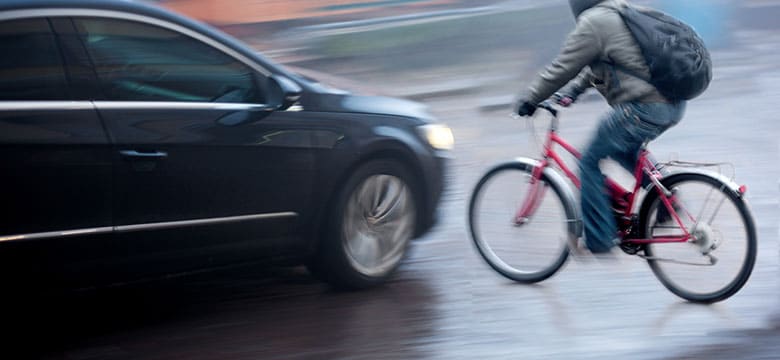 |
| Heart-stopping situations such as the one pictured here can be prevented with better city planning. |
Results? The road was never closed during the construction, and the project has since created a safe and convenient way for cars and bikes to travel simultaneously without either coming into contact with each other.
Do stories of bike metropolises like Amsterdam seem too foreign and unrealistic to even be considered goals? Let’s stay at home and look at Fort Collins, CO, a city that can be traversed on bike paths without ever crossing a city street. Yes, you heard that right.
 |
| A cyclist prepares to safely cross a city road using a toucan crossing. |
The cost of a bike path is significantly less than that of a road. And though it may not be possible in every city to create such an integrated network of bike paths as Fort Collins, there are additional options. Bike lanes paired with “toucan crossings” at intersections recently allowed Fort Collins to create a 5-mile bikeway for under $1 million – a bargain as far as city development is concerned. This bikeway has provided safe travel for cyclists while actually improving the traffic situation for auto travelers.
At the time of the Industrial Revolution when bicycles were invented and beginning to gain popularity, it was cyclists who lobbied for paved roads to replace the deeply trenched dirt roads that made bike travel uncomfortable. It seems this was the only victory cyclists ever had on the road. It’s time to bring the paved roads back to the source from whence they came and give back to the community that made good roads possible in the first place.
| Early photos show the possibility of compromise with side-by-side passageways - trenched, for carriages, and smooth, for bicycles. |
All this stands in stark contrast to the words of former Toronto mayor Rob Ford, who in addition to removing bike lanes from his city, stated that when cyclists are hit by cars, “it's their own fault at the end of the day." This attitude by city officials has resulted in a notably high death rate for cyclists in that city.
In 1817, when Baron von Drais invented the first bicycle, nobody could have known that his contraption would one day be as ubiquitous as a loaf of bread. Now, a car-free city is being built for 80,000 residents near Chengdu, China.
Bicycling was a fad. It was a stepping stone to women’s rights It was a social movement in protest to climate change. It was a form of exercise, it was an Olympic sport, but now for many, it’s a way of life. It’s an environmentally friendly, viable means of transportation that belongs in cities and has potential to improve city travel for all. It belongs in the very cities that are suppressing its existence.
Sources:
https://usa.streetsblog.org/2017/09/20/fort-collins-just-built-five-miles-of-bikeway-for-less-than-1-million-heres-the-trick/
https://www.icebike.org/58-milestones-from-bicycle-history-you-must-know/
https://www.bbc.com/news/magazine-17914504
https://app.slack.com/client/TMEBPTJSY/threads

It seems to me that bike culture is kind of like counterculture: an alternative lifestyle that many have heard of but do not fully understand. As we learned from the modern era, counterculture provided social protest over traditional societal customs that eventually sparked change. Because of its “other” nature, car-drivers may feel superior to, or bigger than, the average cyclist. You clearly want to create space for this niche group.
ReplyDeleteAs a car driver I’m reading this post and left with a little bit of a “yes, and?” mentality. It seems that you want to spark change in communities, which I commend you for. You do a good job of presenting reasons WHY having bikes on the road is beneficial, but I think one way you could make your post more persuasive is to suggest some ways that drivers and cyclists can coexist regardless of road restructuring. Maybe that means fostering respect for each other’s choices, or maybe that means reforming traffic law. Whatever it is, suggesting some facets for change could shift your argument in a really effective way.
While I agree that the current system of roadways is not ideal for bikers and drivers to safely co-exist, city planning and redesigning our roads is not a solution that will work everywhere. Space constraints and limited budgets will hinder our efforts for change in that front. Perhaps we can use design thinking to re-imagine another complementary solution?
ReplyDeleteThe other half of this system is drivers, and when we try to see the issue from their perspective we can realize that (at least for those drivers who aren't jerks) driving with a cyclist can be somewhat intimidating. Drivers often don't understand how they should behave around cyclists - how much room should they leave for them, in what situations should they pass the cyclist, or when should they just slow down? Perhaps in addition to redesigning roads we could also redesign our drivers education program?
It would take more ideation to come to a proper solution - one that would effectively reach a large portion of drivers, but this education approach can certainly aid in helping make the roads safer for all of us.